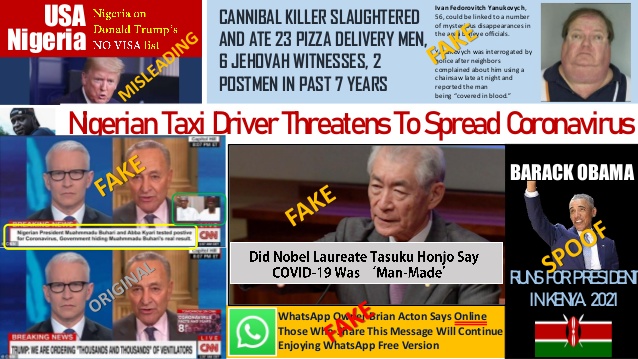DEALING WITH HATE SPEECH AND FAKE NEWS
Lecture presented at the iMedia Virtual Conference of the Online Media Practitioners Association of Nigeria (OMPAN), Imo State Chapter;
By: Emeh James Anyalekwa
OMPAN National President
Date: Sunday, May 31, 2020
__________________________________
Introduction:
In an era where information spreads amazingly fast, one of the resultant effects is people craving to play frontline role in dissemination of information, in manners suggestive of some sort of gains in being the “first to publish” the news. Consequently, a lot of what is churned out is alarming, and it has become a norm overtime to mislead people and contradict stories with ‘catchy headlines.’ While some of these information put out there are a result of shallow research and ignorance, some others are deliberate, with the author meaning to misinform and mislead people, and to spark-off emotional responses.
What does this mean for journalists and media practitioners?
Journalists play a key role in the dissemination of correct information, and information literacy for citizens. However, with the emergence of improved information and communication technologies, comes also faster and wider spread of negative information. This is a challenge, not just for media practitioners, but the society at large. It is, therefore, imperative that journalists upgrade their fact-checking skills, using appropriate technologies and strategies, if they have to occupy frontline in the war against “fake news” and “hate speech.”
What can we do to prevent hate speech?
One of the ways we can fight hate speech is by speaking up. The more we can undermine hate speech with loving words, logical arguments, and truth-telling, the more that hate speech will begin to lose its power.
Another method that can combat hate speech is education. When it comes to bullying, cyberbullying, harassment, and hate crimes, the more people are educated on these issues, the more we can prevent them in the future.
Hate speech/fake news presents a major challenge to today’s journalism. Therefore, everyone has a responsibility to combat the scourge of fake news in the media. This ranges from the promotion of strong norms on professional journalism, supporting investigative journalism, reducing financial incentives for fake news, and improving digital literacy among the general public.
On social media, report to Facebook or Twitter to remove any messages in which people are attacked on the basis of their race, religion or ethnicity. If it is an open-group, ask the administrator or moderator to remove hateful comments or fake news with a warning to the creator.
What else can you do?
React to the hate speech. Even if you are not personally the victim of hate speech, you can do something about it. For example, you can make it clear that you do not agree with a post or status update.
The following tips may be helpful:
1 Do not target the author, but rather the content of the statement;
2 Refute false claims where possible with facts. Refer to reliable sources;
3 Express your disbelief and displeasure, but do not get involved in pointless arguments and insults;
4 Be aware that certain messages are published with the intention to provoke. So don’t get carried away and be provoked.
How to spot and deal with fake news / hate speech
Separating fact from fiction accurately can seem daunting. Keeping oneself up-to-date on what happens in the world is essential for both professional and private reasons. Some listen to the radio, others read newspapers or visit some blogs. Regardless of the source, it is not always easy to tell right from wrong. However, with a few simple precautionary measures, one can easily stay informed while recognising suspicious media content.
1. Develop a Critical Mindset.
One of the main reasons fake news is such a big issue is that it is often believable, which means it’s easy to get caught out. Many fake news stories are also written to create shock value. This means it’s essential that you keep your emotional response to such stories in check. Approach what you see and hear rationally and critically.
Ask yourself, “Why has this story been written? Is it to persuade me of a certain viewpoint? Is it selling me a particular product? Or is it trying to get me to click through to another website?”
2. Check the Source & Author
If you come across a story from a source that you have never heard of before, do some digging! Find out a bit more about the publisher – is it a professional and well-known news agency or is it someone’s personal blog? Is the author a media professional, a public figure or a well-known expert in his/her domain? Is the author citing his/her sources? If sources are absent, it would be useful to cross-check the information with other sources to verify its veracity.
Investigate the source of the page, unusual URLs, site names, or social media profiles try to look like legitimate news or information sites but are not. Check what the web says about the source against what they say about themselves.
Strange-sounding URLs that end in extensions like “.infonet” and “.offer,” rather than “.com” or “.org,” or that contain spelling errors, may mean that the source is suspect.
If the information is something that you have been told by another person, consider his reputation and professional experience. Is he known for his expertise on the matter? Or does he tend to exaggerate the truth?
3. See Who Else Is Reporting the Story
Check whether the story has been picked up by other well-known news publishers. Rather than relying where you first saw the information, go out and fetch same information from a higher quality source. If the information seems true, but a credible mainstream source hasn’t reported it, dig deeper. When it comes to World news, stories from organizations like CNN and BBC, will have been checked and verified beforehand. If the information you have isn’t from a well-known source, there’s a chance that it could be fake.
However, you need to be careful even here. People who spread fake news and “alternative facts” sometimes create web pages, newspaper mockups, or “doctored” images that look official, but are not.
So, if you see a suspicious post or image that looks like it’s from CNN, for example, check CNN’s homepage to verify that it’s really there.
4. Check for Publication date, bad English and Clickbaits
Is the story relevant up-to-date? Does the date of publishing support the date/period of the event?
Credible authors make less repeated spelling and grammatical mistakes. Check for headline grammar error or typo, avoid news in all-caps and exclamation marks.
Beware of articles that compulsorily encourages you to click or share a hyperlinked text, image or video, or sparks off an extreme reaction in you.
5. Examine the Evidence
A credible news story will include quotes from source (which is sometimes, “unnamed”). If these are missing or the source (if “named”) is an unknown expert, question it! But have it at the back of your mind that some quotes can sometimes be “twisted” to back up a particular viewpoint.
6. Look for Fake Images or File Photo
Modern editing software has made it easy for people to create fake images that look professional and real. Some publishers equally pick file photo and make it look as if the story is new and recent. Use tools such as “Google Reverse Image Search” (https://images.google.com) to check if that particular image had been altered, or had appeared in older stories.
7. Check That It “Sounds Right”
Use your common sense! If a story sounds unbelievable, it probably is. Bear in mind that fake news is designed to “feed” your biases or fears. And, remember, just because a story sounds “right” and true, doesn’t mean that it is.
For example, it is unlikely that your favorite phone maker or network provider is giving away a million free phones or airtime to people who turn up to a suspecting website.
Conclusively, as “hate speech” and “fake news” continue to threaten the peace, unity and corporate existence of the world and Nigerians in particular, I believe that if more journalists and bloggers were made to realize the possible consequences of these things, they would have acted better; they would have been more critical. Since hate speech and fake news are spread through the media, public trust in the media is negatively affected, thus the high level of public distrust and scepticism of the media.
We must recognise that hate speech can harm individuals, communities and societies. Targets of hate speech can experience negative emotional, mental, and physical consequences. These can include low self-worth, anxiety, fear for their lives, depression and even self-harm or suicide. Hate speech harms everyone. They are designed to inflame our emotions and prevent us from evaluating the truth or falsity of the claim.
There is no cure for hate speech, but there is a way to stand up against it. Speak out against hate speech – fight racism and bigotry with love, empathy, compassion, and strength. We may not be able to eliminate hatred entirely, but the more steps we can take to educate and support human beings, and speak out against injustice, the better this world will become – bearing in mind that hate speech (including name-calling, racist comments, hateful phrases) is a precursor or even a prerequisite for violence.
Thank you for your attention.
Useful Links:
Fact Checking sites for fake news
Factcheck.afp.com
Africacheck.org
Factcheck.org
Snopes.com
Info on Site Domains
Whois.net
Domainbigdata.com
Images originality
https://images.google.com/
https://tineye.com/
https://www.duplichecker.com/reverse-image-search.php
Exifdata.com
Videos
Invid-project.eu
Example of Fake News








